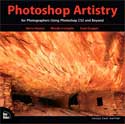
Photoshop Artistry for Photographers using CS2 and Beyond
By Barry Haynes, Wendy Crumpler, and Sean Duggan
New Riders Press
www.newriders.com
ISBN 0-321-34699-8
536 pages
US $55.00, CAN $69
For photo enthusiasts who are looking to immerse yourselves in the personal and commercial application of Adobe Photoshop CS2, Photoshop Artistry puts this college level course right in your lap. What this book doesn’t offer are easy guidelines for users to help them get more “zing” out of their pictures. There are numerous books and manuals on the market to satisfy that need.
What this book does offer is an in depth immersion into the world of commercial Photoshop CS2 usage. The three authors have former incarnations of this book on the shelves, this being the updated and expanded version. They’ve had plenty of experience in teaching, through books and actual college classrooms, and their expertise shines through.
Photoshop Artistry is set up to be a course, as in classroom, and the instructions are ample and detailed. There are also suggested course outlines for beginners, intermediate, and advanced students. The accompanying DVD is interactive and necessary to use the book (course) properly. Example: the student must use the DVD to calibrate the monitor if a calibrator is not available. Set up of the students’ equipment and Photoshop’s Preferences to course specs is a must in order to follow the curriculum through its intensive lessons. This book is nuts and bolts, to be sure, but a lot more practical than a manual. And a lot easier to read.
In the chapter on Preferences and Color Settings, the authors start right in with setting up the custom Artist Keys in order to facilitate the student with shortcuts and menus. This also includes some settings for the Adobe Bridge. NOTE: If you’ve been doing Photoshop CS2 before taking this course be aware of the Preferences settings described in this chapter. They are indicative of this course and are not touted as being the only way to set the Preferences to use Photoshop. The student should make these Preferences itemized here in order to take this course, and, as described by the authors, can later customize the Preferences to his or her liking when the course is done. The authors show, in great detail, how to customize your own shortcuts.
In an effort to be perfectly clear and explain the depth of the lesson at hand there are any number of “Refer To”s throughout the book. This involves turning to related chapters in order to shed more light on the lesson. There’s some page turning here and there. Do not lose sight of the fact that this is a full-blown course, not a simple help book. Stick with it, take your time, and you will learn from these very capable and experienced guides.
If there was a byword for this workflow it would be “efficiency.” The authors take plenty of time explaining how and why they set up the “workspace” as they do. This, combined with the shortcuts and key commands make for a very efficient set up.
By the time we get into Chapter 4, The Toolbox, the student is ready for the specifics of each tool. From keyboard shortcuts to description and uses of the tools we begin to get into what makes Photoshop operate as it does. The section on Image Editing Tools shines. The explanations are concise and then they move on. By the time we get into Chapter 5, Picking and Using Color, the student should be chomping at the bit (no pun) to make some images.
As the material develops the authors take the students through the basics: the aforementioned Toolbox and all of its aspects, Image Editing Tools, History Brush, and Vector Tools which work on shapes rather than pixels. Color is explained in detail and you’ll be shown how to create custom color libraries in Photoshop. The reader will learn about Selections and Channels, Masks and Quick Masks, Paths, and a very good chapter, “Layers, Layer Masks, Layer Comps,” which teaches the Layers concept clearly from the fundamentals.
Chapter 10, Automating Photoshop, can teach the ardent Photoshop user how Automating can remove some of the drudgery from constant work. Batch files and Droplets are introduced. This is where efficiency kicks in.
The authors talk about Printing and Scanning in concise and knowledgeable language. Types of printers and scanners are discussed in some detail. You will learn about inks, papers, and calibrating printers and way beyond.
I could list all the areas and subjects covered by this book. Let me tell you that just about every aspect of Adobe Photoshop CS2 and of printmaking is covered in this tome. The authors are experienced and daily Photoshop users. They know their subject. If you want to know “the drill” start from the beginning of this course, take your time, and when you get done you’ll be able to do just about anything you want to an image in the most precise and efficient way possible.
I recommend this book for those who want to take advantage of the myriad of features in Photoshop CS2, while being instructed by talented, experienced and inventive commercial photographers. At the very least it will economize your moves and create an efficient imaging environment. At the very most it will take you up several levels in your abilities as a digital photographer and printer, and that can be the difference between good, and great.

Leave a Reply
You must be logged in to post a comment.